Magnetization of Wiegand Wires with Varying Diameters and Analysis of Their Magnetic Structure via Hysteresis Loops
Abstract
1. Introduction
2. Materials and Methods
3. Results
3.1. Major Hysteresis Loops
3.2. Minor Hysteresis Loops
4. Discussion
4.1. The Simple Magnetic Structure of Wiegand Wires with Varying Diameters
4.2. Model for Calculating the Volume of Region of Magnetization
4.3. Magnetization Process and Magnetic Structure of Wiegand Wires with Varying Diameters in an Applied Magnetic Field
5. Conclusions
Author Contributions
Funding
Institutional Review Board Statement
Informed Consent Statement
Data Availability Statement
Conflicts of Interest
References
- Wiegand, J.R.; Velinsky, M. Bistable Magnetic Device. U.S. Patent 3,820,090, 25 June 1974. [Google Scholar]
- Wiegand, J.R.; Velinsky, M. Method of Manufacturing Bistable Magnetic Device. U.S. Patent 3,892,118, 1 July 1975. [Google Scholar]
- Takahashi, K.; Takebuchi, A.; Yamada, T.; Takemura, Y. Power supply for medical implants by Wiegand pulse generated from a magnetic wire. J. Mag. Soc. Jpn. 2018, 42, 49–54. [Google Scholar] [CrossRef]
- Sun, X.; Yamada, T.; Takemura, Y. Output Characteristics and Circuit Modeling of Wiegand Sensor. Sensors 2019, 19, 2991. [Google Scholar] [CrossRef] [PubMed]
- Sun, X.; Iijima, H.; Saggini, S.; Takemura, Y. Self-Oscillating Boost Converter of Wiegand Pulse Voltage for Self-Powered Modules. Energies 2021, 14, 5373. [Google Scholar] [CrossRef]
- Abe, S.; Matsushita, A.; Naoe, M. Annealing and torsion stress effect on magnetic anisotropy and magnetostriction of Vicalloy fine wire. IEEE Trans. Magn. 1997, 33, 3916–3918. [Google Scholar] [CrossRef]
- Tanaka, H.; Yamada, T.; Takemura, Y.; Abe, S.; Kohno, S.; Nakamura, H. Constant velocity of domain wall propagation independent of applied field strength in vicalloy wire. IEEE Trans. Magn. 2007, 43, 2397–2399. [Google Scholar] [CrossRef]
- Kohara, T.; Yamada, T.; Abe, S.; Kohno, S.; Kaneko, F.; Takemura, Y. Effective excitation by single magnet in rotation sensor and domain wall displacement of FeCoV wire. J. Appl. Phys. 2011, 109, 07E531. [Google Scholar] [CrossRef]
- Takemura, Y.; Yamada, T. Output Properties of Zero-Speed Sensors Using FeCoV Wire and NiFe/CoFe Multilayer Thin Film. IEEE Sens. J. 2006, 6, 1186–1190. [Google Scholar] [CrossRef]
- Kohara, T.; Kusunoki, T.; Yamada, T.; Suzuki, T.; Fujimoto, H.; Takemura, Y.; Abe, S.; Kohno, S.; Itoi, H.; Kaneko, F. Fabrication and implementation of a rotation sensor using a separated structure consisting of magnetic wire and a pick-up coil. J. Magn. Soc. Jpn. 2010, 34, 347–351. [Google Scholar] [CrossRef]
- Dlugos, D.J. Wiegand Effect Sensors Theory and Applications. Sensors 1998, 15, 32–34. [Google Scholar]
- Matsushita, A.; Takemura, Y. Power generating device using compound magnetic wire. J. Appl. Phys. 2000, 87, 6307–6309. [Google Scholar] [CrossRef]
- POSITAL-FRABA. Innovative Encoders for Demanding Applications. Available online: https://pr-toolbox.com/pdf/FRABA_AbsoluteEncoders.pdf (accessed on 23 March 2023).
- Takemura, Y.; Fujiyama, N.; Takebuchi, A.; Yamada, T. Battery-less hall sensor operated by energy harvesting from a single Wiegand pulse. IEEE Trans. Magn. 2017, 53, 4002706. [Google Scholar] [CrossRef]
- Serizawa, R.; Yamada, T.; Masuda, S.; Abe, S.; Kohno, S.; Kaneko, F.; Takemura, Y. Energy harvesting derived from magnetization reversal in FeCoV wire. In Proceedings of the IEEE Sensors, Taipei, Taiwan, 28–31 October 2012. [Google Scholar]
- Takahashi, K.; Yamada, T.; Takemura, Y. Circuit parameters of a receiver coil using a Wiegand sensor for wireless power transmission. Sensors 2019, 19, 2710. [Google Scholar] [CrossRef] [PubMed]
- Felix, H.; Andreas, B. Direct Observation of Large Barkhausen Jump in Thin Vicalloy Wires. IEEE Magn. Lett. 2020, 11, 1–4. [Google Scholar]
- Nakamura, T.; Tanaka, H.; Horiuchi, T.; Yamada, T.; Takemura, Y. Surface Magnetization Reversal of Wiegand wire Measured by the Magneto-Optical Kerr Effect. Materials 2021, 14, 5417. [Google Scholar] [CrossRef]
- Sha, G.; Yang, C.; Song, Z.; Takemura, Y. Magnetic Interaction in Wiegand Wires Evaluated by First-Order Reversal Curves. Materials 2022, 15, 5936. [Google Scholar] [CrossRef] [PubMed]
- Jiang, L.; Yang, C.; Song, Z.; Takemura, Y. Magnetic Structure of Wiegand Wire Analyzed by First-Order Reversal Curves. Materials 2022, 15, 6951. [Google Scholar] [CrossRef]
- Yang, C.; Kita, Y.; Song, Z.; Takemura, Y. Magnetic Reversal in Wiegand Wires Evaluated by First-Order Reversal Curves. Materials 2021, 14, 3868. [Google Scholar] [CrossRef]
- Cabanas, A.M.; Pérez del Real, R.; Laroze, D.; Vázquez, M. First-Order Reversal Curves of Sets of Bistable Magnetostrictive Microwires. Materials 2023, 16, 2131. [Google Scholar] [CrossRef]
- Yang, C.; Sakai, T.; Yamada, T.; Song, Z.; Takemura, Y. Improvement of pulse voltage generated by Wiegand sensor through magnetic-flux guidance. Sensors 2020, 20, 1408. [Google Scholar] [CrossRef] [PubMed]
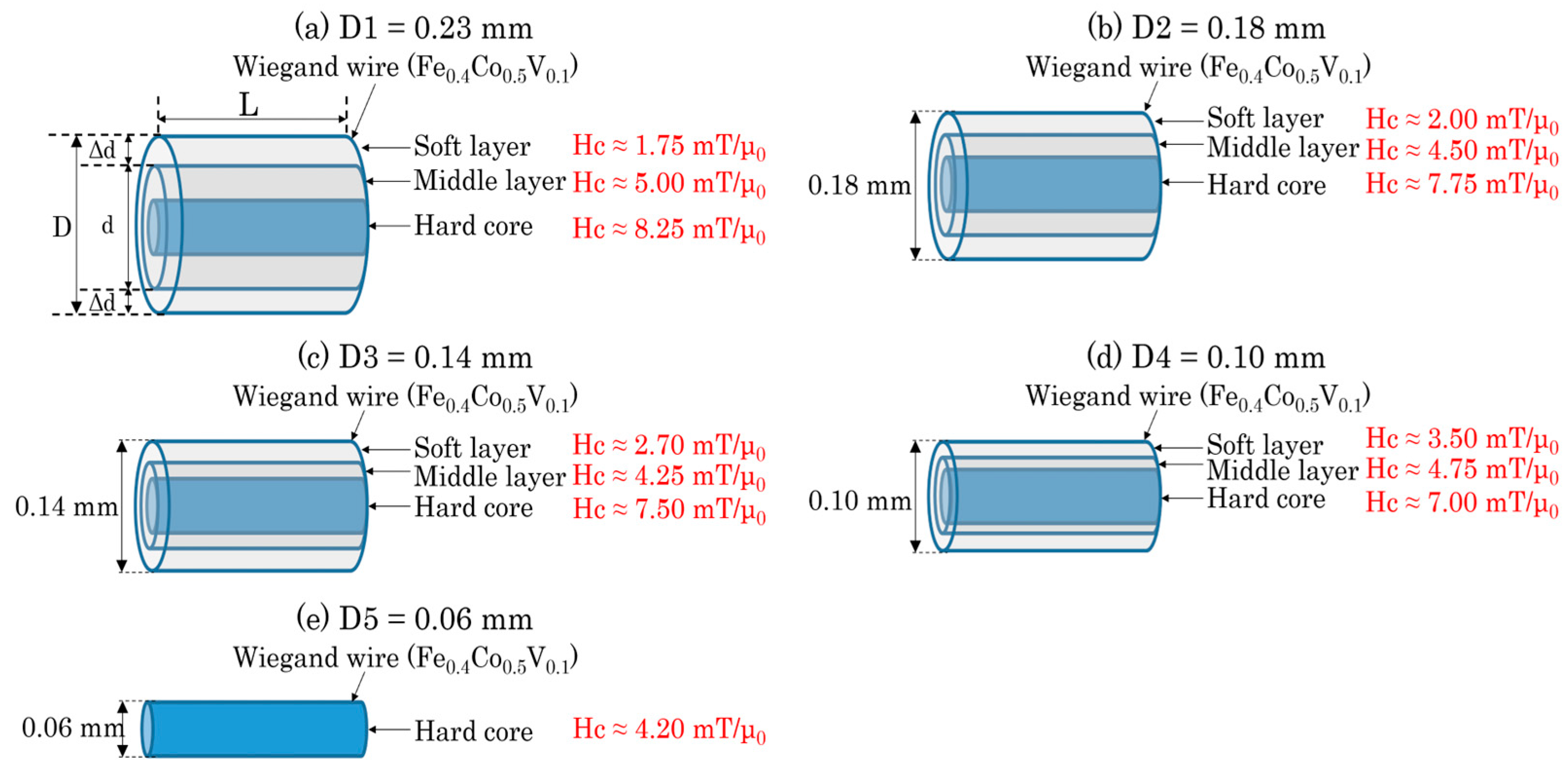
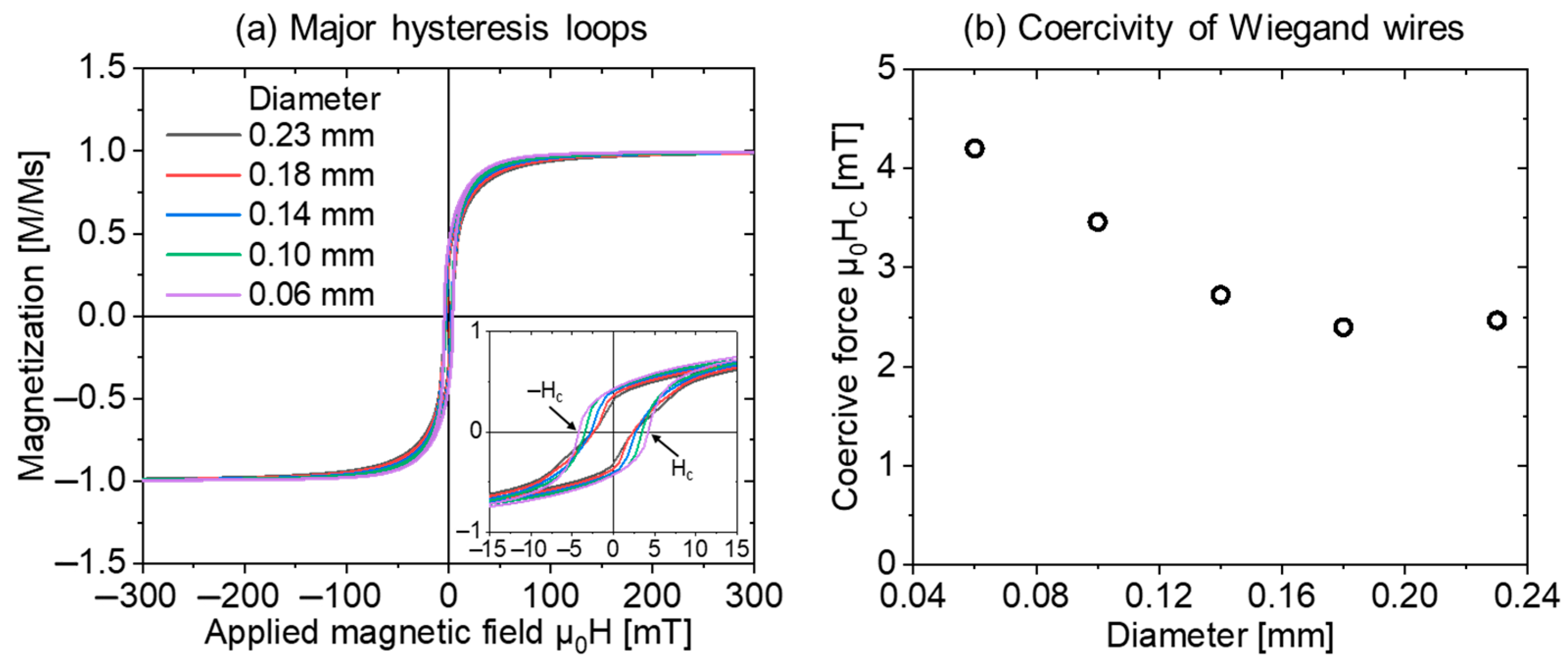
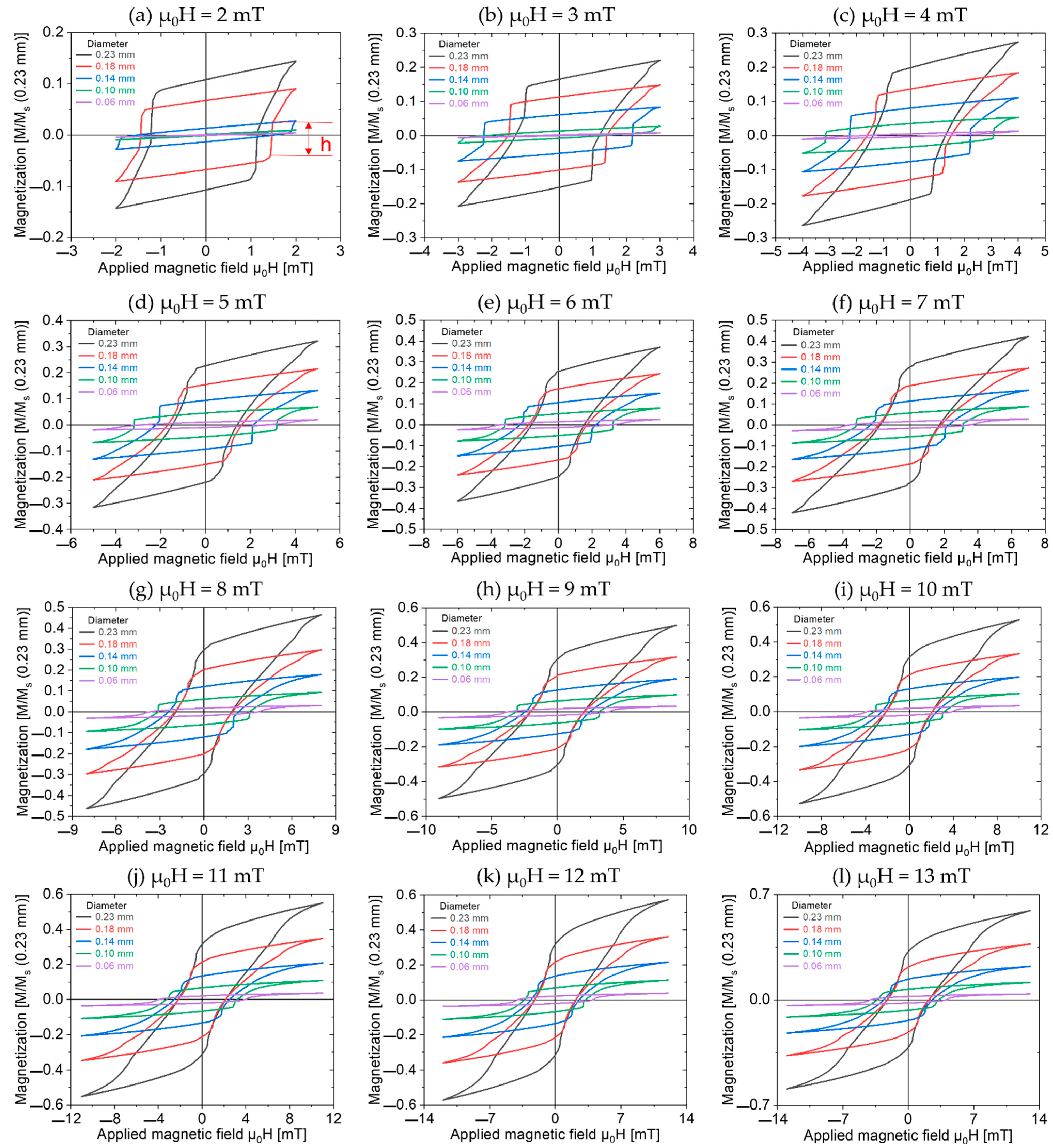
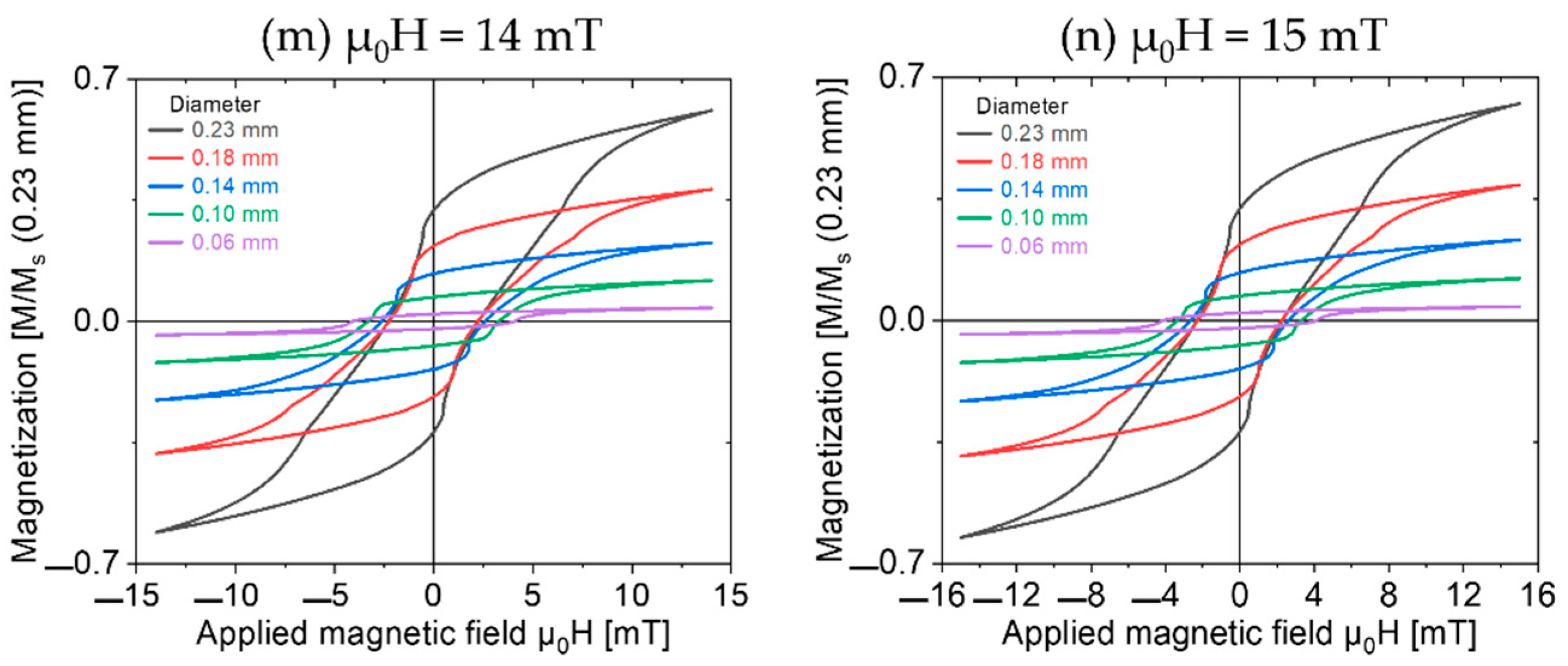


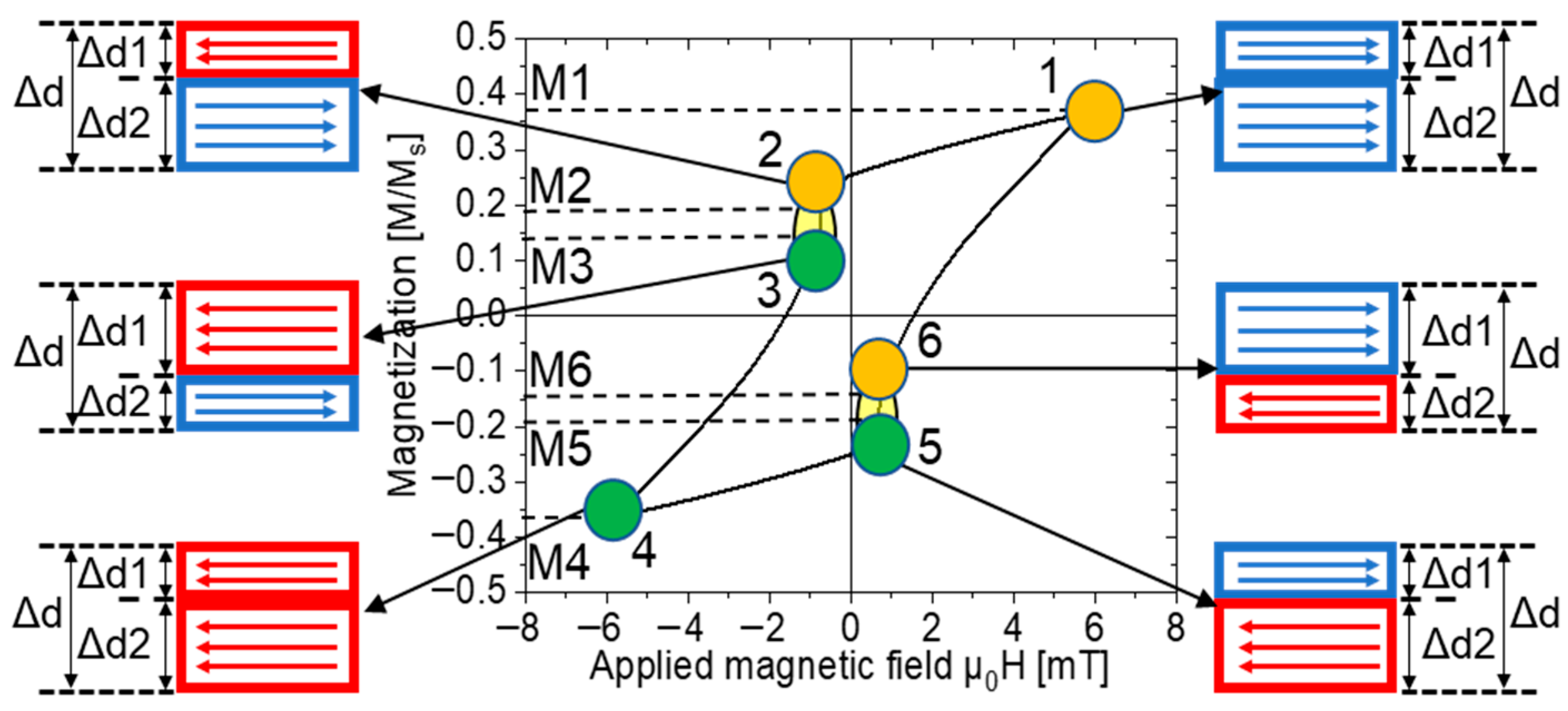
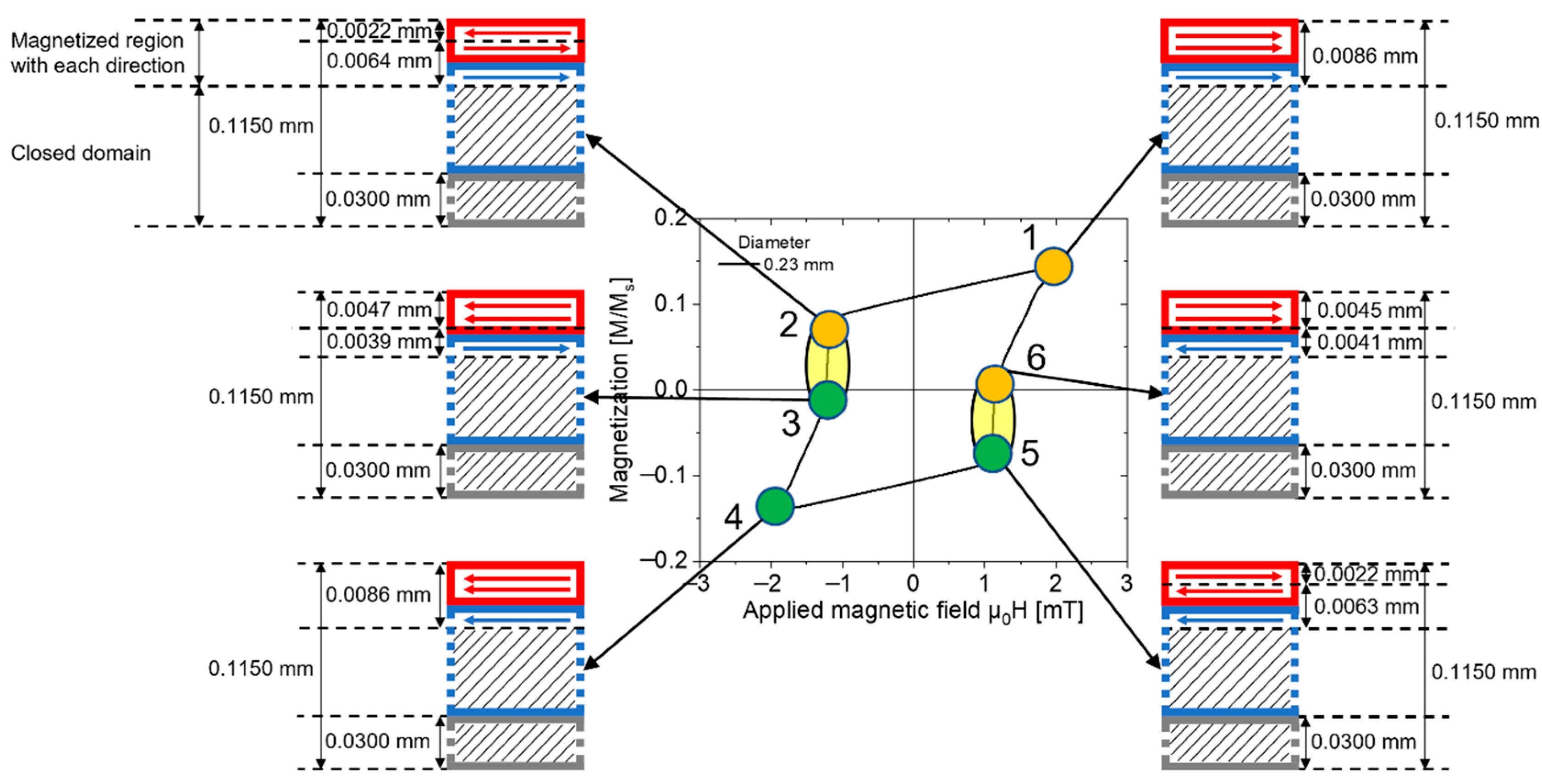
| Magnetic Field (mT) | Points | D = 0.23 mm | D = 0.18 mm | D = 0.14 mm | ||||||
|---|---|---|---|---|---|---|---|---|---|---|
| Δd (mm) | Δd1 (mm) | Δd2 (mm) | Δd (mm) | Δd1 (mm) | Δd2 (mm) | Δd (mm) | Δd1 (mm) | Δd2 (mm) | ||
| 2 | 1 | 0.0086 | 0.0000 | 0.0086 | 0.0070 | 0.0000 | 0.0070 | 0.0029 | 0.0000 | 0.0029 |
| 2 | 0.0086 | 0.0022 | 0.0064 | 0.0070 | 0.0020 | 0.0050 | 0.0029 | 0.0019 | 0.0010 | |
| 3 | 0.0086 | 0.0047 | 0.0039 | 0.0070 | 0.0044 | 0.0026 | 0.0029 | 0.0024 | 0.0005 | |
| 4 | 0.0085 | 0.0000 | 0.0085 | 0.0070 | 0.0000 | 0.0070 | 0.0029 | 0.0000 | 0.0029 | |
| 5 | 0.0085 | 0.0022 | 0.0063 | 0.0070 | 0.0019 | 0.0051 | 0.0029 | 0.0019 | 0.0010 | |
| 6 | 0.0085 | 0.0045 | 0.0041 | 0.0070 | 0.0044 | 0.0026 | 0.0029 | 0.0024 | 0.0005 | |
Disclaimer/Publisher’s Note: The statements, opinions and data contained in all publications are solely those of the individual author(s) and contributor(s) and not of MDPI and/or the editor(s). MDPI and/or the editor(s) disclaim responsibility for any injury to people or property resulting from any ideas, methods, instructions or products referred to in the content. |
© 2023 by the authors. Licensee MDPI, Basel, Switzerland. This article is an open access article distributed under the terms and conditions of the Creative Commons Attribution (CC BY) license (https://creativecommons.org/licenses/by/4.0/).
Share and Cite
Jiang, L.; Yang, C.; Song, Z.; Takemura, Y. Magnetization of Wiegand Wires with Varying Diameters and Analysis of Their Magnetic Structure via Hysteresis Loops. Materials 2023, 16, 3559. https://doi.org/10.3390/ma16093559
Jiang L, Yang C, Song Z, Takemura Y. Magnetization of Wiegand Wires with Varying Diameters and Analysis of Their Magnetic Structure via Hysteresis Loops. Materials. 2023; 16(9):3559. https://doi.org/10.3390/ma16093559
Chicago/Turabian StyleJiang, Liang, Chao Yang, Zenglu Song, and Yasushi Takemura. 2023. "Magnetization of Wiegand Wires with Varying Diameters and Analysis of Their Magnetic Structure via Hysteresis Loops" Materials 16, no. 9: 3559. https://doi.org/10.3390/ma16093559
APA StyleJiang, L., Yang, C., Song, Z., & Takemura, Y. (2023). Magnetization of Wiegand Wires with Varying Diameters and Analysis of Their Magnetic Structure via Hysteresis Loops. Materials, 16(9), 3559. https://doi.org/10.3390/ma16093559






